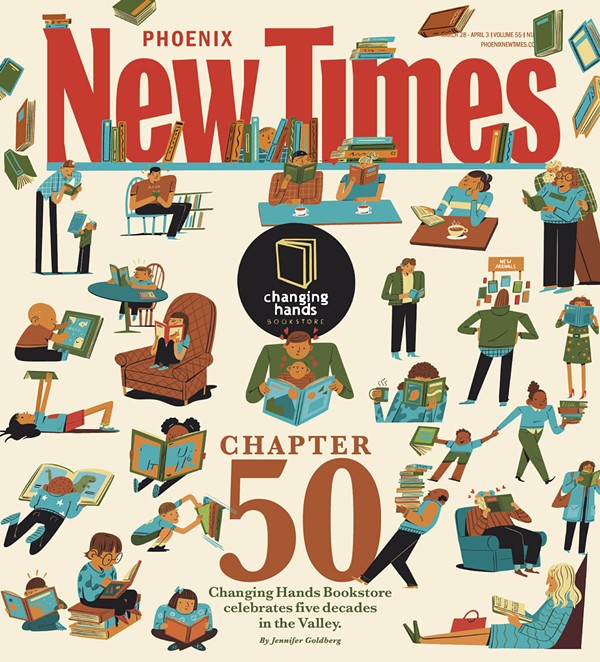Born and raised near Glendale, Martin David Robinson (later shortened to Robbins) lived the cowboy lifestyle most country singers only gleaned from watching Roy Rogers movies. For two years, he tried maintaining his permanent residence in Arizona while tending to a burgeoning music career in Nashville. When relocation seemed inevitable, it was with more than a heavy heart that he and his wife, Marizona, and their 4-year-old son, Ronald Carson, drove past the sign that read, "Leaving Phoenix, population 250,000." That was in 1953. Each time they returned, it seemed like another 100,000 had enlisted in their absence.
Ronny Robbins has now spent 47 of his 51 years in Music City. These days only funerals seem to bring him back to Phoenix. "I'd love to move back to Phoenix if I can find a place just like it used to be. That's probably Tucson," he says with a laugh.
For Ronny, Phoenix "like it used to be" entails 112 to 115-degree temperatures with 6 percent humidity and driving around Cave Creek when there weren't any paved roads. Sometimes Marty would let his preteen son take the wheel while he'd go shooting rabbits. The Robbins family continued to make treks from Nashville to the Valley every summer and Christmas. It was during one Christmas road trip that Ronny recalls hearing "El Paso" for the first time -- and not on the car radio, either.
"We had a turquoise Cadillac, and that's what I remember we were in when he wrote it," he says. "My mother was driving, I was in the front seat and Daddy was in the back seat with his little guitar and a yellow legal pad just writing down words as fast and furiously as he could. And I'm thinking, "Man, that song is like a movie. A real neat story.' I'm thinking he wrote it over two consecutive Christmases. Never finished it and picked it back up that second year. It wasn't anything I thought was going to be of interest to anyone else but him and me. There were six or seven minutes of verses at one time that he cut down."
Even with that pruning job, "El Paso" became the song that would break the two-and-a-half-minute time barrier in pop music, as well as become the first No. 1 pop record of the '60s and the first recipient of a "Country" Grammy. And Gunfighter Ballads and Trail Songs, the album "El Paso" rode in on, became the biggest seller of Marty Robbins' career.
Now those records sound like the desert. Even without the regional lyrics, songs like "They're Hanging Me Tonight," "Running Gun," "The Master's Call" and "Big Iron" would've screamed desert landscapes to a cabby stuck in New York City rush-hour traffic, if only for the sparse production or the desolation in Robbins' plaintive cry.
You can't rerelease the desert, but you can digitally remaster its songs, and maybe that's as close to a piece of old Arizona as we're ever going to get. While the Gunfighter album has never slipped out of print, its recent rerelease as part of Sony Legacy's "American Milestone" series marks the first time this legendary album has been given the extensive liner notes, original packaging and bonus cut treatment. Quite a far cry from the label's initial lukewarm reaction to an album of songs about determined lawmen and bad-tempered cowboys.
Ronny recalls: "CBS didn't want to do it, couldn't have cared less about western music at the time. It wasn't their idea of what commercial material was. But Daddy said, "I'm going to cut it anyway.' They did the whole Gunfighter album in four and a half hours. It wasn't something they spent a lot of time with. One, because he didn't feel like CBS was going to put it out. Or if they did, they wouldn't get behind it. But it took off like gangbusters.
"This album is still their best seller. It may have gone platinum [it has]. CBS doesn't tell me a lot anymore. They have control of the audio material, and they can market it a lot better than I can."
In the '70s, Ronny had his own musical career. Before that he performed with his dad as "Marty Robbins Jr." Columbia Records not only released the lone "Jr." album in 1969, but affixed a "Proudly Presents" to its title as well. When Ronny is told the album is available on eBay, he chuckles and warns, "Don't pay too much for it."
Not a big fan of touring, he quit making music, and since the late '80s has tended to the family business, Marty Robbins Enterprises, which reserves right of approval over everything that carries his father's name, besides those sound recordings. "We market various home videos of his TV shows and live concerts; that's primarily what our business is now," Ronny says.
If Columbia made it its business to second-guess Marty Robbins in the first eight years of his career, Ronny has made it his to second-guess his father's wishes and protect that hard-won artistic integrity since the singer's death in 1982. Not only must he preserve Marty Robbins' name and likeness from appearing in cheap and unsavory endeavors, he must also keep that name and likeness from fading out of the public's fickle consciousness. That's not so easy to do in Nashville. Just as Arizona was quick to pave over its greatest natural resource to become more cosmopolitan, so has Music City given its rich music history short shrift. If it hasn't paved over its cowboy heritage altogether, it's done a thorough job of confining old country music and its stars to museum exhibits and remote AM frequencies.
"Nowadays history only goes as far back as Garth's fifth album," Ronny says with a sigh. "That's as far as anyone looks anymore."
Unless someone creates a Country Music History Month, most people won't even know who Jimmy Dickens was or how huge a star he was at the time he discovered Marty Robbins.
In 1951, Marty Robbins was host of a local television show on KPHO called Western Caravan. "It started out as a 15-minute radio show at KTYL in Mesa, which I think was the forerunner of KPHO," Ronny Robbins says. "One day the station manager told him he would have to do a TV show if he wanted to keep the radio program, and he was petrified! While he had that show, Jimmy Dickens was coming through Phoenix promoting a Grand Ole Opry show. He heard Daddy, and when the tour got to L.A., he told Art Sadlee, the West Coast A&R man for CBS Records, about this kid in Phoenix he needed to go and hear.
"Within six months, Robbins had secured a record deal with Columbia, a writing deal with Acuff-Rose Publishing and an invitation to join the Grand Ole Opry as a member. This convinced him he had to move to Nashville. "I don't think Daddy really liked Nashville as such, after growing up in Arizona," says Ronny. "He had really bad hay fever, and Nashville is the allergy capital of the world. He always said he had claustrophobia in Nashville because he could never see two or three miles ahead."
Equally shortsighted, as far as Marty Robbins was concerned, was Mitch Miller, he of Sing Along With Mitch fame as well as Columbia's powerful A&R man on the East Coast. One of Miller's more successful hit-record formulas was coupling pop arrangements with proven country-western hits. Tony Bennett scored a massive hit with his cover of Hank Williams' "Cold Cold Heart," but at least Williams recorded on another label. When Robbins scored a huge country chart-topper with "Singing the Blues," Miller got another Columbia recording artist, his pet protégé Guy Mitchell, to cover the song instead of promoting Robbins' efforts on the pop charts.
"Daddy sold about a half a million records, which in country was a pretty good seller," recalls Ronny. "Then Guy Mitchell covered him and sold two million copies in the pop field. That got under Daddy's skin real bad. But he was a young act back then and didn't really have a lot of clout. Then he did "Knee Deep in the Blues,' which didn't do as well, and Guy Mitchell covered him on that, too. So by then he was raising all kinds of Cain with CBS.
"Apparently he called their bluff, or they let him bluff them, because the next thing you know he was flying to New York to cut a record with Mitch Miller and the Ray Conniff Singers. It wasn't that he wanted to cut pop, he just didn't want someone else in pop cutting his material. That was the big battle with CBS and he basically won that battle."
In the process, he'd written "A White Sport Coat and a Pink Carnation," which turned out to be the cream of the crop of that whole session. It was a No. 1 country hit and a No. 2 pop hit. "Guy Mitchell didn't cover him on that one," says Ronny, laughing.
At those same sessions, Mitch Miller produced "The Story of My Life," which turned out to be the first hit for songwriters Burt Bacharach and Hal David. This led to more pop-oriented songs, including a second Bacharach/David tune called "Sittin' in a Tree House." While Robbins turns in a fine vocal performance, the big problem here was casting. By now Robbins had appeared on enough TV programs for people to know he was a grown man of 32 years. It's one thing for an older man to sing about the story of his life. It's quite another to have the same grown man rushing out after supper to go kiss his "favorite girl" in a tree house -- it makes him seem like either a pervert or, worse, a cheap date. To add the finishing touch, Mitch Miller, apparently envious of Alvin's recent chart success, grafted chipmunk background vocals onto the song. Six months after "Sittin' in a Tree House," Robbins would be noticeably more comfortable dangling from "The Hanging Tree."
"Teen songs, that was where the market was," Ronny says. "American Bandstand was out, all these national teen dance shows were on. "White Sport Coat' got that all started, and when that ran dry, he did "The Hanging Tree.' That kind of gave him a little insight, because that's something he thoroughly enjoyed doing; it took him back home. He saw there was a market for western songs and felt CBS owed him an album, because he had done well with the other ones. They owed him a chance to do something he wanted to do."
CBS, determined to strong-arm "El Paso" into 1959 commercial standards, issued a "Special Edition Radio Version" to DJs which had a radically butchered two-minute, 58-second version while relegating the complete four-minute, 37-second cut to the flip side. But no DJ with two working ears could've aired that unlistenable shortened rendering.
Ronny always thought that the only edited "El Paso" that existed was the four-minute-and-19-second one that appeared on the original Gunfighter album. Gunfighter marked perhaps the only time an album version proved shorter than the single version; it excised just one verse, the one in which Robbins shows remorse for having shot the handsome young stranger.
Ronny says his father was incensed about the truncated version, and the younger Robbins thought he was complaining about the 18-second cut on the Gunfighter album. It turns out Marty was carping about the much shorter DJ edit. "It makes me upset just listening to it now," Ronny says. "It's not only butchered, they sped it up a third so he sounded like Mickey Mouse. It wasn't even edited properly; some of the splicing is just pathetic."
Never commercially available, the radically condensed version came to Ronny's attention on a cassette a fan sent him. Don't bother looking for it on the Sony/Legacy reissue -- or mentioned in the liner notes, either. "I'm not sure they even have that mix, but I hope they microwaved it or something," he says with a laugh. "I think what they did remastering it, it does really sound good."
But after you remaster a masterpiece, what next? "El Paso" -- the movie!
"I have been talking about an "El Paso' movie on and off for years, but the timing hasn't been right and the deal hasn't been right," says Ronny. You may think you've already seen an "El Paso" movie in which Marty Robbins starred, but that was actually called Ballad of the Gunfighter. "El Paso" was used as its orchestrated opening theme music, but the story was based on his song "San Angelo," which was actually written as a sequel to "El Paso" and appeared on the predictably titled album More Gunfighter Ballads and Trail Songs.
Ronny picks up the story. "Felina was a bartender who owned a saloon in San Angelo, and during the movie she recollects this young cowboy 20, 25 years ago. The little girl Secora who works at the saloon falls in love with an outlaw who robs stagecoaches and takes the money to a monastery, a Robin Hood type. It was pretty much a B-movie."
"El Paso" may also extend its shelf life as the spokessong for Old El Paso, maker of fine packaged Mexican foods. "That's something I pursued 15 years ago," says Ronny. "They pooh-poohed it then because they were trying to update their image. But I'm thinking, "Old El Paso? It's not a particularly updated image that you'd want.' So that's kind of being regenerated. It's something I had to look at long and hard because they are asking to change the lyrics. It could be a substantial amount of income, but on the other hand the song gets diluted in the process. Over a period of time, it could turn into, "Hey, good lookin', whatcha got cookin', how's about cookin' something up with cheese?'"
If the idea of a gunfighter falling in love with a plate of refried beans sounds, well, cheesy, the notion of a permanent Marty Robbins museum seems a more a befitting memorial. "We did have our own museum at Music Village [in Nashville]. . . . We were there for five years," notes Ronny. "There was a conflict between Music Village and Twitty City we chose not to be involved in, so when our lease was up we chose a temporary location close to Opryland. Because of obvious politics, it couldn't be a Marty Robbins museum without ticking off other Opry members, but they did give us a nice portion of the museum.
"Among the Marty memorabilia are his jewelry collection, several guitars, family history exhibits, some interactive video-type displays, the last car he raced a month before he died, the outfit Marty was wearing in Clint Eastwood's film Honky Tonk Man and some manuscripts on Ramada Inn notepads. Unfortunately, Ronny couldn't find the legal pad bearing "El Paso." "I wished I could've found that," he sighs. "But I did find "All Around Cowboy,' one or two others."
In the beginning, the Opry exhibit featured Robbins, Hank Snow and Patsy Cline. Then Jim Reeves and some others were added, and room started running out in hillbilly heaven. "We did have to downsize it some and put some of the stuff in storage," admits Ronny.
Though there's often been talk of starting a Marty Robbins museum in the Valley, it has yet to come to fruition. Robbins is reluctant to talk about The Friends of Marty Robbins, the organization that Juanita Buckley Najera started six years ago with the intent of building a Robbins museum in Glendale. Najera stretched the usual boundaries of devotion when she purchased the onetime home of Marty's twin sister in Glendale. She even paid two grand for one of his belts. Ronny wouldn't care so much if she confined her collecting to real estate and leather goods. The fact that the organization collected donations and put on concerts in his father's name for five years with no museum in sight gets under his skin.
"For danger of getting sued for libel or slander, I'm not going to say an awful lot, but I don't support 'em. I did at one time, but it's just not being handled in a way I like. They were selling stuff I told them not to sell. They had some stuff on an Arizona Online Web site, a hideous painting of Daddy by Juanita's ex-husband that they were selling posters of. We had our attorney send a cease and desist. It's not their Web site, so I don't know how current it is, but it's still on there."
Arizona Online, an Internet provider-sponsored site, still has some active pages with images from the inactive museum as well as the unauthorized merchandise allegedly bearing Marty Robbins' likeness. The museum exhibit amounts to little more than a glass case full of fan mementos and a Richard Najera sketch of the singer on a "Friends of Marty Robbins" tee shirt, which looks more like some forgotten president with a tobacco-chewing habit. And at one time, you could purchase a 14-by-17-inch poster of Najera's Marty Robbins portrait for $10. "The original painting is not for sale as it belongs to the Marty Robbins exhibit," reads the blurb beneath.
If anyone should be serving Najera with a cease and desist, it's Sylvester Stallone, who looks like he's been hijacked to star in the story of Marty Robbins' life. Attempts to order this poster via the fax number only produced the voice of a confused latchkey child on the other end of the phone. But it still burns Ronny up.
"Najera can sell that picture as an artist, but when he sells a reproduction, there's a copyright issue involved. He doesn't have the right to copyright reproductions of Daddy, according to his will. Mama's the only one that has the right to do that."
According to Sandy Daens, Marty Robbins Fan Club president since 1989, The Friends of Marty Robbins was never recognized as an official fan club. "The only fan club I'm aware of is mine. Juanita was calling hers a fan club, but she got kicked out of the International Fan Club organization. If you're a member of that organization, you have to commit to sending your members a certain amount of things per year, so many newsletters a year, and she just wasn't fulfilling her obligation. I was getting letters from people who had joined her fan club and they weren't getting anything."
Daens, who worked for Marty Robbins as a personal assistant in the year before his fatal heart attack, is still very close to the Robbins family. When the discord with Ronny became known, she withdrew her support for the museum. "I have disassociated myself with the whole mess," Daens says. "There's nothing I can talk about on the record. I used to promote their shows in my newsletter and give coverage to it. I don't even make mention of it anymore."
The Glendale Public Library began organizing Marty Robbins tribute concerts on the singer's birthday (September 26) in the mid-'90s, but even that institution is no longer involved. Daens didn't know if a concert was planned for this year. "Last I heard, Juanita moved and got a P.O. box number and no one knows what's going on," Daens says.
New Times' numerous calls to Juanita Najera at the Friends of Marty Robbins number were never returned; requests to see the exhibit items were not answered, hardly the sign of a thriving organization. With the Najeras divorced and Juanita no longer even living in Glendale, Ronny figures this organization has collapsed under its own weight.
It's a road Ronny has been down before. He's determined to stay out of court. "There are no winners in court cases," he says. "I'm in a no-win situation with this 'cause it's gonna look like I'm trying to close down somebody that's trying to do a good thing. That happened 15 years ago. A guy out in Phoenix named Chet was doing a Friends of Marty Robbins-type thing where he was raising money to rename Grand Avenue "Marty Robbins Avenue.' Well, Grand Avenue is 27 miles long. There's a lot of people who didn't want their address changed. He was out there going to concerts, setting up a booth in back and raising money for this. No one ever had any accounting for it.
"I finally got the authorities after him and I got blistered in the press about it because I was shutting this guy down. That guy was just a scam artist. That all kinda fell through. I got an injunction on the guy to keep him from collecting money. I've got to protect my father's name and image."
That the name remains untarnished owes a lot to Ronny's efforts and to the fact that everyone seemed to love his father. "Marty did things his own way and didn't care what people said about him," remembers Daens. "I think that's one of the reasons he was able to have hit songs for 30 years. He was the kind of guy you'd meet and instantly love him. Nobody had a bad thing to say about him, and you can't say that about everybody in the music business."
And when you think of Marty Robbins, music still comes to mind first. He may have made some compromised pop recordings on the road to "El Paso," and there may have been some forgettable B-movies, but not enough of either to be indelibly identified with the artist. And as long as Ronny's on the case, you probably won't see anything like the kitsch that's been put out on Elvis Presley, at least not for long.










